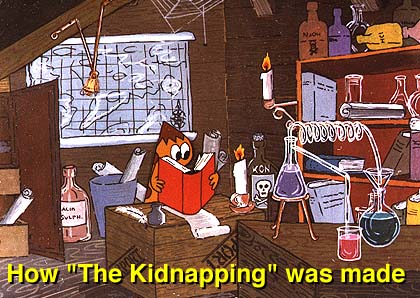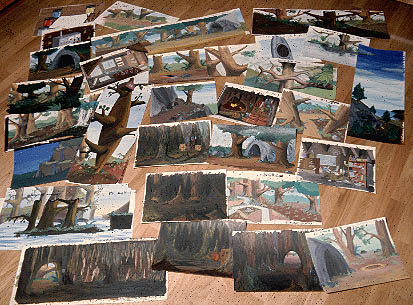
NOTE: The information and the images are Copyright 1997-2012 ANI-MATO J-E Nystrom, and may NOT be published or distributed in any form. You may only publish the web address.
Please note: This page contains many large images (total: 230K). If you want to see them all, you'll have to wait a while...

Back in 1972, when I was working on "The Kidnapping", the project that was to become my first successful, "official" film, I made a little brochure about the production process. The brochure's pages are reproduced here. I hope you find something useful in them. Many of the subjects are also covered on my other pages, so do browse my site!
The story is developed as a "storyboard", a giant-sized comic strip. As the story develops, new drawings are added to the storyboard. Since the drawings are pinned onto a cork board, it is easy to make alterations to the story.
Before the tedious drawing work can begin, the dialogue is recorded on tape and then transferred onto magnetic film. This filmstrip is analyzed in a sound reader, and every syllable is registered on an "exposure sheet" - necessary to obtain perfect synchronization between sound and picture. The sheet is divided into many rows, each corresponding to one frame of film. Music and sound effects aren't usually recorded until after the film is finally cut, and an optical sound track is then prepared and printed onto the film, see below.
and of course a LOT OF INSPIRATION
Here are some of the backgrounds I painted for this film:
For more info on some of my films, see my Filmography.



 The backgrounds are painted on cardboard or celluloid with tempera, acrylic or sometimes even oil paints. The backgrounds are the "landscape" in which the characters are moving, and they are often made into large-size panoramas, "pan backgrounds", considerably larger than the picture format. The camera follows the characters as they move across the background. This background is painted in a format suitable for a vertical camera move.
The backgrounds are painted on cardboard or celluloid with tempera, acrylic or sometimes even oil paints. The backgrounds are the "landscape" in which the characters are moving, and they are often made into large-size panoramas, "pan backgrounds", considerably larger than the picture format. The camera follows the characters as they move across the background. This background is painted in a format suitable for a vertical camera move.



 Now the real work begins. Every second of finished film consists of 24 frames, requiring 12 to 24 drawings, depending upon the speed of movement - faster movements need more drawings per second, slower moves can be animated with less, with three or even more frames shot of every drawing. The difference between two successive frames can be almost negligible, an arm moves a fraction of a millimeter, for instance. The animated drawings are filmed on black & white film to check the smoothness of the movements (this is called a pencil test).
Now the real work begins. Every second of finished film consists of 24 frames, requiring 12 to 24 drawings, depending upon the speed of movement - faster movements need more drawings per second, slower moves can be animated with less, with three or even more frames shot of every drawing. The difference between two successive frames can be almost negligible, an arm moves a fraction of a millimeter, for instance. The animated drawings are filmed on black & white film to check the smoothness of the movements (this is called a pencil test).
 In order to superimpose the animated characters on the backgrounds, the drawings are copied onto transparent sheets of celluloid or plastic, usually called "cels". The lines are traced in ink, and the colors are filled in on the reverse side of the cels, in order to get completely even colors when viewed from the front.
In order to superimpose the animated characters on the backgrounds, the drawings are copied onto transparent sheets of celluloid or plastic, usually called "cels". The lines are traced in ink, and the colors are filled in on the reverse side of the cels, in order to get completely even colors when viewed from the front.

 The filming is carried out on an "animation stand". Sometimes the picture is divided into several levels (4 on this "multiplane" stand), separated by about 30 cm, or 12". The fore- middle- and backgrounds of the landscape are on different levels, so a certain 3-dimensional effect is achieved, especially when the camera or background is moving.
The filming is carried out on an "animation stand". Sometimes the picture is divided into several levels (4 on this "multiplane" stand), separated by about 30 cm, or 12". The fore- middle- and backgrounds of the landscape are on different levels, so a certain 3-dimensional effect is achieved, especially when the camera or background is moving.
To make an 8-minute animated cartoon you need:
7000 sheets of paper 7000 sheets of celluloid
150 sheets of cardboard 50 felt-tip pens
10 crow-quill pens 50 pencils
5 erasers 20 brushes
10 liters (2 1/2 gal.) of paint 2.5 dl (1/2 pint) of india ink
1200 meters (3600 ft) b&w film 240 meters (720 ft) color film

